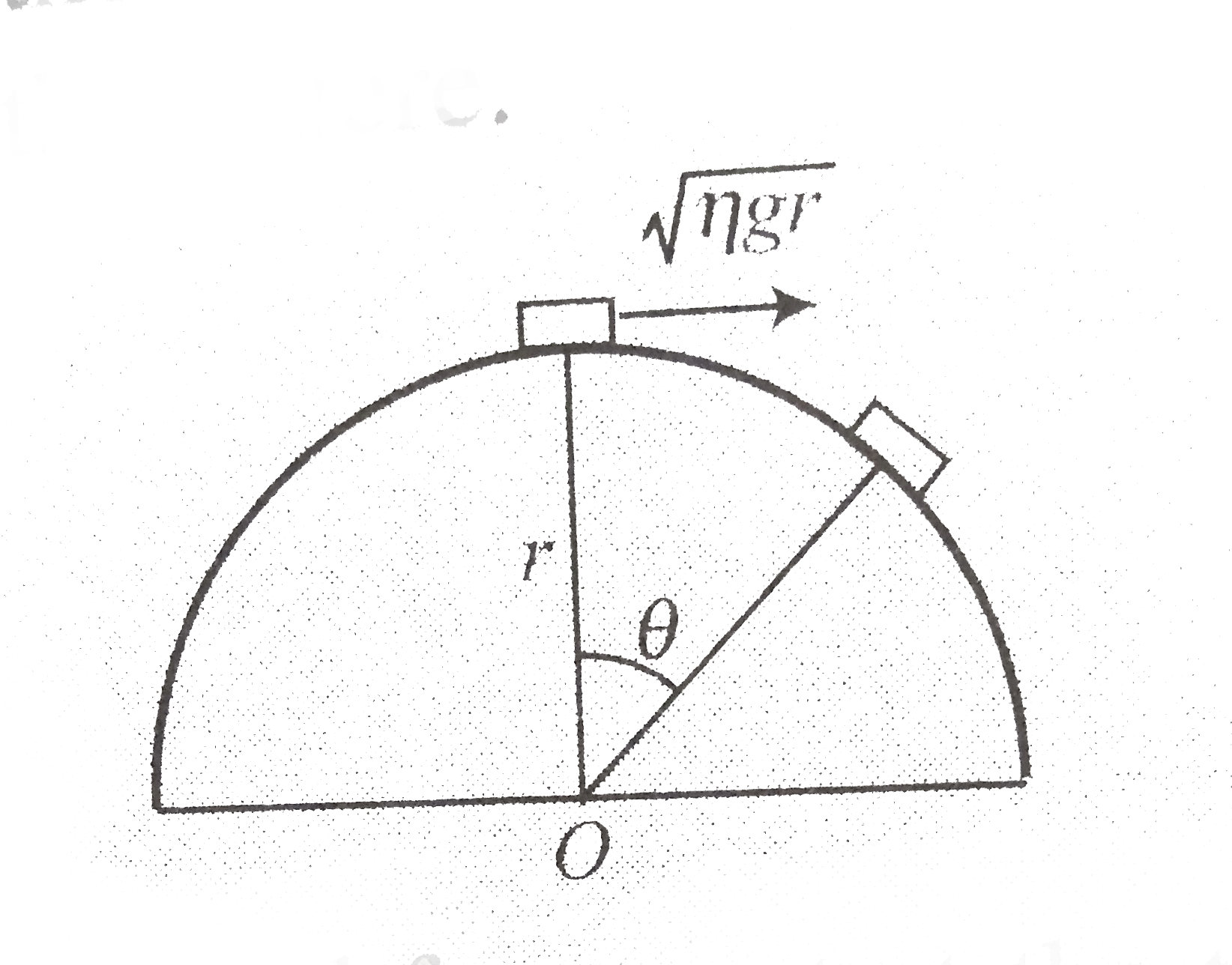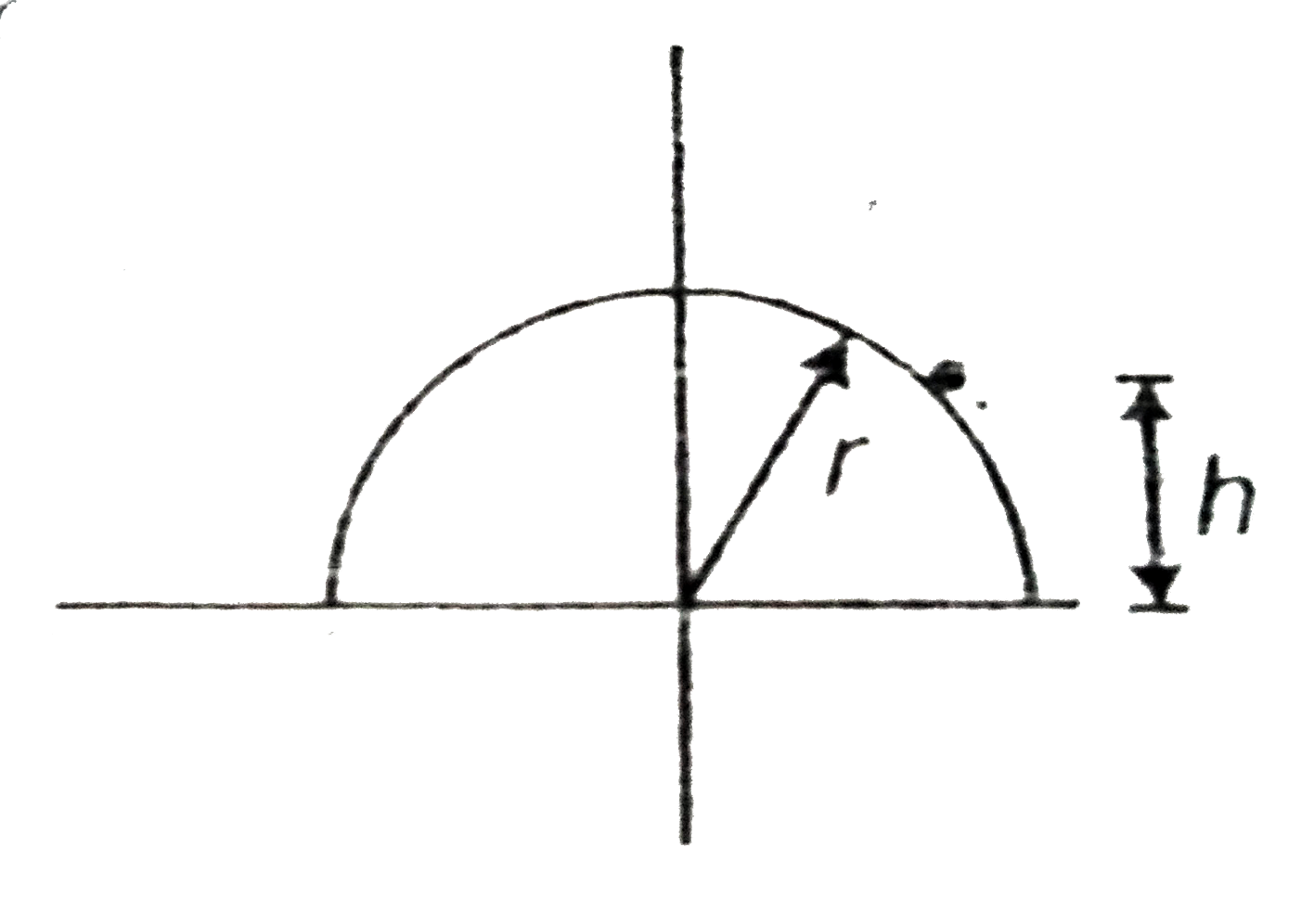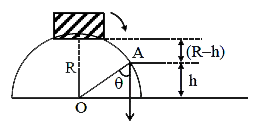A small disc is on the top of a hemisphere of radius . What is the smallest horizontal velocity that should fbe given to the disc for it to leave the hemisphere and not slide down it?[There is no friction]
The correct Answer is:B
To solve the problem of finding the smallest horizontal velocity v that should be given to the disc for it to leave the hemisphere and not slide down it, we can follow these steps:
Step 1: Understand the Forces Acting on the Disc
When the disc is at the top of the hemisphere, two forces act on it:
1. The gravitational force mg acting downwards.
2. The normal force N acting perpendicular to the surface of the hemisphere.
Step 2: Apply the Condition for Circular Motion
For the disc to maintain contact with the hemisphere while moving in a circular path, the net force acting towards the center of the hemisphere must provide the necessary centripetal force. The equation for centripetal force is given by:
N+mgcos(θ)=mv2R
where θ is the angle the radius makes with the vertical, R is the radius of the hemisphere, and v is the velocity of the disc.
Step 3: Determine the Condition for Losing Contact
The disc will lose contact with the hemisphere when the normal force N becomes zero. Therefore, we set N=0 in the centripetal force equation:
mgcos(θ)=mv2R
Step 4: Simplify the Equation
Since N=0, we can simplify the equation:
mgcos(θ)=mv2R
Dividing both sides by m (mass of the disc):
gcos(θ)=v2R
Rearranging gives us:
v2=gRcos(θ)
Step 5: Find the Minimum Velocity
The minimum velocity occurs at the point where the disc is just about to lose contact with the hemisphere. This happens when θ=0 (at the top of the hemisphere). Thus:
v2=gRcos(0)=gR
Taking the square root gives us:
v=√gR
Conclusion
The smallest horizontal velocity v that should be given to the disc for it to leave the hemisphere and not slide down it is:
v=√gR
When the disc is at the top of the hemisphere, two forces act on it:
1. The gravitational force mg acting downwards.
2. The normal force N acting perpendicular to the surface of the hemisphere.
For the disc to maintain contact with the hemisphere while moving in a circular path, the net force acting towards the center of the hemisphere must provide the necessary centripetal force. The equation for centripetal force is given by:
N+mgcos(θ)=mv2R
where θ is the angle the radius makes with the vertical, R is the radius of the hemisphere, and v is the velocity of the disc.
The disc will lose contact with the hemisphere when the normal force N becomes zero. Therefore, we set N=0 in the centripetal force equation:
mgcos(θ)=mv2R
Since N=0, we can simplify the equation:
mgcos(θ)=mv2R
Dividing both sides by m (mass of the disc):
gcos(θ)=v2R
Rearranging gives us:
v2=gRcos(θ)
The minimum velocity occurs at the point where the disc is just about to lose contact with the hemisphere. This happens when θ=0 (at the top of the hemisphere). Thus:
v2=gRcos(0)=gR
Taking the square root gives us:
v=√gR
The smallest horizontal velocity v that should be given to the disc for it to leave the hemisphere and not slide down it is:
v=√gR
Topper's Solved these Questions
Similar Questions
A very small particle rests on the top of a hemisphere of radius 20cm. Calculate the smallest horizontal velocity to be given to it if it is to leave the hemisphere without sliding down its surface, take g=9.8m/s2.
View SolutionA very small particle rests on the top of a hemisphere of radius 20 cm. Calculate the smallest horizontal velocity to be given to it if it is to leave the hemisphere without sliding down its surface. Take g=9.8ms−2.
View Solution
Knowledge Check
- Question 1 - Select One
A partcle rests on the top of a hemisphere of radiu R. Find the smallest horizontal velocity that must be imparted to the particle if it is to leave the hemisphere without sliding down it-
A√gRB√2gRC√3gRD√5gR - Question 2 - Select One
A partcle rests on the top of a hemisphere of radius R. Find the smallest horizontal velocity that must be imparted to the particle if it is to leave the hemisphere without sliding down :
A√gRB√2gRC√3gRD√5gR - Question 3 - Select One
A small particle rest on the top of a hemisphere of radius 20 cm .The smallest horizontal velocity os given to it , if it is to leave the hemisphere without sliding down to its surface ,is
A0.7m/sB1.4m/sC2.8m/sD5.6m/s
A particle rests on the top of a smooth hemisphere of radius r. It is imparted a horizontal velocity of √ηgr. Find the angle made by the radius vector joining the particle with the vertical at the instant the particle losses contact with the sphere.
 View Solution
View SolutionA small body of mass m slides without friction from the top of a hemisphere of radius r. At what hight will the body be detached from the centre of hemisphere?
 View Solution
View SolutionA small block slides down from the top of hemisphere of radius R = 3 m as shown in the figure. The height 'h' at which the block will lose contact with the surface of the sphere is __________ m.
(Assume there is no friction between the block and the hemisphere)
 View Solution
View SolutionA particle of mass m is released from the top of a smooth hemisphere of radius R with the horizontal speed μ. Calculate the angle with verticle where it loses contact with the hemisphere.
View SolutionA body rest on the top of a hemisphere of radius R. What will be the least horizontal velocity imparted to it , if it has to leave the hemisphere without sliding down?
View Solution

